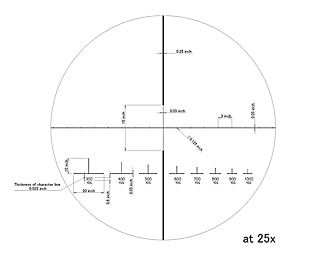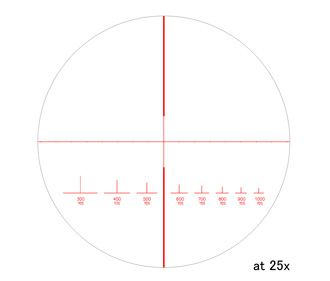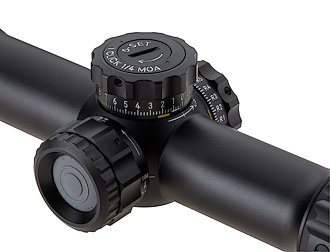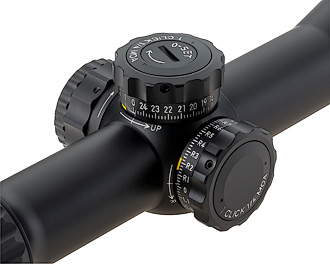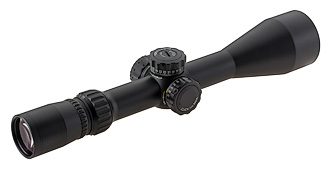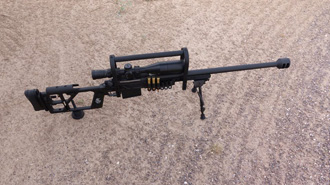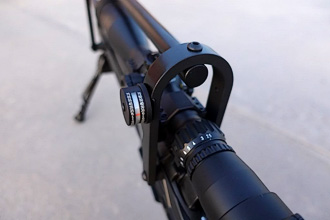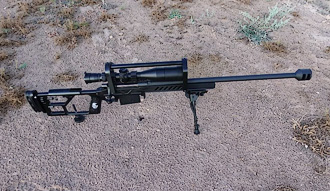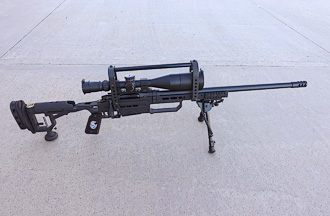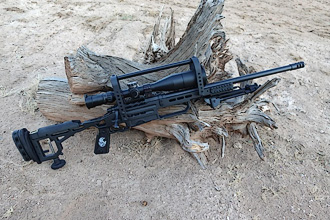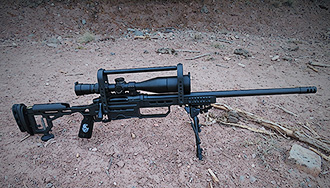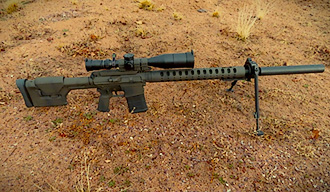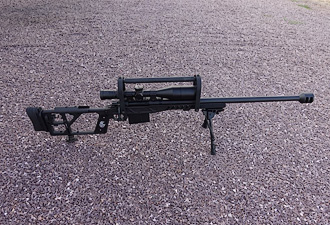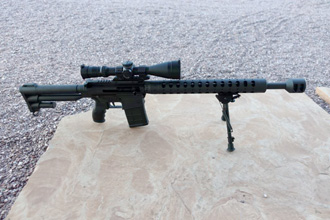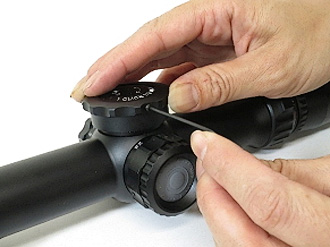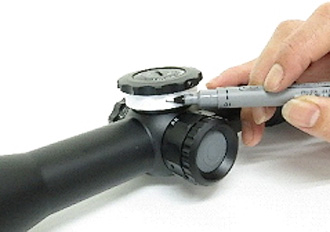|
D&L Custom Scope Reticle
|
||||||||||
The D&L Tactical reticle will be in a new scope starting in 2019, a 2.5x - 25x 52mm tactical scope with zero stop and illuminated reticle. The D&L reticle is simple and field practical. It is the only reticle to ever win the triple crown of ITRC shooting: The overall International Tactical Rifleman's Championship, The Carlos Hathcock Shoot off, and the Golden Egg Shoot (one cold shot hit on a chicken egg at 500 yards.) It has been the most effective scope reticle in gaining entry to the OMC ( The One Mile Club: Knocking down a 11" x 16" target at 1800 yards) |
||||||||||
The collaboration project between March Optics and DLS inc has been a success and scopes are available for shooters who want the state of the art in field practical rifle scopes. These scopes are available direct from DLS Inc for those wanting an optic mounted and zeroed on their next MR-30PG rifle build. At a time when so many different scopes and reticles are available on the shooting market it is only logical to ask why this scope reticle is the right choice for your precision rifle. The answer is simple: proven field practical performance. This scope reticle has continually evolved since it was first designed by Dave Lauck in the 1980s. The D&L MR-30PG rifle and this scope reticle has been the only precision shooting combination to ever win the triple crown of tactical shooting, and do so all in the same year: The International Tactical Rifleman’s Championships, The Carlos Hathcock Shootoff, and the Golden Egg Shoot (hitting a chicken egg with one cold shot at 500 yards). It has also been the most frequent reticle used to successfully gain entry into the One Mile Club (hitting a 11” x 16” target at 1800 yards). Now that the reticle is available in March precision rifle scopes it is state of the art in clean, crisp clarity. March has become the choice of champion riflemen on an international basis. It is the recommended optic for your next precision rifle build from DLS Inc. The 2.5x – 25x magnification range has proven to be excellent for all around tactical / hunting / field competition use from 0 – 2000 yards. We have tried nearly all magnification ranges on the market and continue to return to this 2.5 – 25x magnification bracket. The optical advancements by March Optics allow the scopes to be field durable, reliable, crisp, clear and bright without being overly large and heavy. (This scope is approximately 13” long and 24oz.) The 52mm objective lens on this scope makes for a compact package with great performance. The reticle itself was designed to be clean and simple. No clutter or confusing grid patterns with so many aiming points that they lead to mistakes in the field. The reticle allows for simple use under field conditions. No complicated formulas and math equations which commonly lead to mistakes, as well as wasted time. While hosting the ITRC we encouraged shooters to bring scopes and gear they thought would work best under field conditions. There were no restrictions related to optics. We wanted to see what worked and what failed. Shooters would show up to the ITRC with a wide range of gear and ideas, including computer driven programs to help them solve the realistic field shooting problems provided by the ITRC competition. It was very common to see shooters so wrapped up in technology solutions for field shooting challenges that they missed shooting opportunities, or failed due to confusion. These failures included instructors who were teaching the program they were using. Then shooters realized that simple and reliable techniques were most practical when shooting under field conditions. The D&L reticle was designed for use with second focal plane scopes. First focal plane scopes have come on strong over the last decade, but much of this has been due to promotional hype. Now that shooters have experienced how thick first focal plane reticles become at high magnification, and how small targets can be blocked by the thick reticle, there has been a swing back to second focal plane scopes. The second focal plane scope gives the same reticle size appearance at all magnifications. The only thing you need to remember when using the D&L second focal plane reticle in the field is: when ranging with the reticle, set the scope on maximum power (25x). This was done because the power ring stops at 25x. This means you can get the power ring setting right every time without even looking at it. Maximum magnification also means you will have the most precise reticle placement over the target, thus achieve the most accurate range estimation. The D&L reticle was designed to be in spacings which are familiar to you in your daily activities: inches and yards. The spacing between the windage dots on the crosswire is 3” on 25X @ 100 yards. Simple to use, simple to remember. Tactical shooters seeing a 6” wide face target being bracketed between the two centermost dots will realize the target is at 100 yards. Seeing a face target bracketed between the vertical crosshair and the next dot will cause you to realize the target is at 200 yards. At longer ranges, from 300 yards to 1000 yards, the shooter uses the inverted T brackets at the bottom of the scope’s field of view. With the magnification set on 25x, place the intersection of the inverted T on the adams apple of the target. The vertical line of the T is 10” tall at the designated distance. The horizontal line of the T is 20” wide. Choosing the inverted T which most closely fits the target’s head and shoulders will give you the approximate distance to the target. This system works well when your range finder goes down. Hunters and target shooters can apply the known sizes of the inverted Ts to their targets when conducting reticle comparison range estimation. The distance between the two thick ends of the vertical crosshair is 10” at 100 yards on 25x. This spacing allows shooters on a KD range to create a diagram in their data book that positions the thick part of the crosshair at the top of their target and mark the point on the diagram where the crosshair intersects the target. The farther away the target is from the shooter, the farther down the crosshair will be on the target. This is another form of simple and effective reticle comparison range estimation. Once distance is estimated, and confirmed with multiple other methods, the elevation can be dialed in for a precise shot. The March scope has ¼ moa click adjustments, but this is complication you can do away with when you use a speed turret inscribed with your own personal load data. Developing information for your speed turret should be done live fire on a known distance range, not via a computer program. Doing things right is the right way to do things, even if it is more work. Once this data is known and inscribed on your speed turret you do not have to count clicks, you simply dial to the correct distance inscribed on the turret. This March scope has a zero stop so you will not get lost in your turret revolutions. Since wind is a variable factor, holding for wind is more field practical than dialing for wind. The dots on the horizontal crosshair of the D&L reticle help you when holding for wind deflection. Simply remember that the dot spacing in 3” at 100 yards on 25x. This means the dot spacing is 6” at 200 yards, 9” at 300 yards, 12” at 400 yards, 15” at 500 yards, 18” at 600 yards and so forth. Estimate the wind deflection based on your load, and apply the correct hold off dot. Shooters operating in low light conditions will benefit from the illumination feature on this March scope. The illumination intensity can be adjusted with the simple push of an external button, the turret does not have to be removed for internal adjustment. More information can be found in the Advanced Tactical Marksman book by Dave Lauck. |
||||||||||
| The March model number of this scope is MAR1102 with the MTR-DL reticle. This scope comes with March tactical turrets which are easy to use, durable, repeatable and waterproof. | ||||||||||
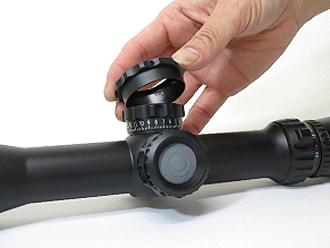 Shooters who are skilled in field practical shooting recognize the value of having a rifle scope with a zero stop, and a blank turret on which to temporarily write, or permanently inscribe their 'come up' DATA. This eliminates the need to 'do math' or 'count clicks' under field conditions. Shooters must do their own DATA development on a 'known distance' range or in sync with their own range finder to develop the exact DATA for their shooting system of rifle, scope, conditions and ammunition. Once a custom elevation 'speed turret' is inscribed with your personal ballistic data for your shooting conditions you simply need to range the target and dial the elevation turret to that range. If there is any question about what turret revolution the scope is on, simply dial down to the pre-set zero stop, then dial to the correct range from that known zero stop point. Blank speed turrets are now available for the March 2-25x - 52mm scope with custom DL reticle. Ultra-simple installation: simply install the speed turret over the existing stock turret and snug it into place. |
||||||||||
|
||||||||||
